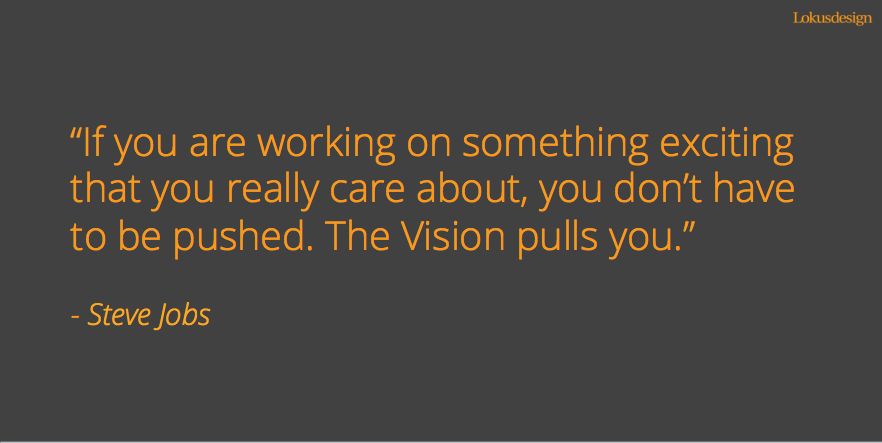6 Points to consider while defining your Brand’s Vision
 Behind some of the most game-changing businesses in the world lay a vision… a vision of what they aspired to achieve… a vision that gave the business a strong sense of direction. Visionaries such as Steve Jobs have challenged the status quo and have gone ahead to build brands that people trust and love. In a post-Jobs world, Elon Musk and his companies have been focusing on building a solar-electric future. This vision, while perhaps over-idealistic, is transparently clear. And it hits home. And perhaps it is because of this clarity that Tesla and Musk find their breed of ardent supporters.
Behind some of the most game-changing businesses in the world lay a vision… a vision of what they aspired to achieve… a vision that gave the business a strong sense of direction. Visionaries such as Steve Jobs have challenged the status quo and have gone ahead to build brands that people trust and love. In a post-Jobs world, Elon Musk and his companies have been focusing on building a solar-electric future. This vision, while perhaps over-idealistic, is transparently clear. And it hits home. And perhaps it is because of this clarity that Tesla and Musk find their breed of ardent supporters.
What is a Brand Vision?
While it can be easy to pass off a brand’s purpose, vision, and mission as interchangeable terms, in reality, these are separate entities in the branding universe.
As we have written previously, everything the brand does is driven by its guiding “Purpose”. If the “Purpose” defines “Why” the brand exists, brand vision defines “Where” the brand is headed/the destination (or at least the next big milestone/ pitstop) of the brand’s journey. In a sense, Brand Vision is a “vivid, aspirational (yet accessible) snapshot of the Brand’s imagined future/ or the world it seeks to create”.
The Mission, on the other hand, highlights “How” the brand intends to realize its purpose and its vision, and “What” this means to its customers. It typically clarifies all the tangible and intangible benefits that the customers would avail over their engagement with the brand across multiple touch points.
As such, Vision is more future-focused and while Mission is centered around the present.
MasterCard envisions “a world beyond cash”. This statement elucidates ‘where’ the brand is headed… to a future that does not need cash in the wallet.
Their mission statement reads, “”Every day, everywhere, we use our technology and expertise to make payments safe, simple and smart”. The statement clearly shows ‘how’ they plan to achieve this world beyond cash.
While there can’t be a standard template to follow while defining your brand’s vision, it would certainly help to consider the following points in doing so:
1) Is it authentic to the brand?
Brand Vision should be driven by Brand Purpose, which in itself is driven by the Brand’s Values and its Positive Valence. If there is a disconnect here, it will lead to strategic confusion which will hamper decision making at multiple levels.
2) Is it aspirational?
A vision statement must be aspirational. It should evoke emotions not only with the customers, but with the employees of the organization and make them feel like they are a part of something big.
3) Is it achievable and believable?
A vision statement is not about crafting lofty unachievable ideas. There must be an element of believability in it. People can only be engaged with something that is authentic and believable.
4) Is it clear?
The brand vision has no room for ambiguity. Nothing is implied. It is not aimed to please anyone or anything. Hence, it is imperative for a vision statement to be worded clearly, in a concise and easy to understand language that is free of jargon and complexity.
5) Is it collective?
The brand vision has to be shared by every individual in the organization irrespective of the hierarchy. This inspires them to work towards a common goal and helps the organization achieve success.
6) Is it stable?
Brand Vision cannot change with every season. It has to offer a long-term perspective and should be unlikely to be impacted by market or technology changes at least in the short to medium term. At the same time, it should be general enough to encompass all of the organization’s interests and strategic direction.
Having said that, as markets evolve and economies change, the brand vision must evolve as well. Otherwise, the vision could become redundant and chaos would reign supreme. Microsoft, for example, began with the vision of “A computer on every desktop, and in every home.” Once that was achieved their vision evolved to “a world where people and businesses can achieve more”.
A strong Vision can help brands in pushing the envelope further, to contribute to and eventually to change the world around them. Companies like Harley Davidson, Apple, Google, Ikea, Amazon etc. pushed that envelope and in return, the world rewarded them by making them what they are today. Unforgettable and Iconic.
Looking for help in defining a strong Vision for you brand? Write to us on info@lokusdesign.com

